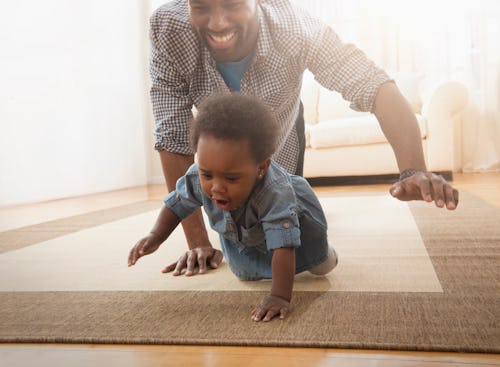5 Reasons Parents Should Worry Less About Developmental Milestones

Developmental milestones — rolling over, babbling, transitioning to solid food, mastering a pincer grasp — are a huge source of anxiety for parents. Every parent wants to know that their kid is developing in a healthy way. Unfortunately, baby milestones are neither an effective way to measure cognitive growth nor particularly helpful to parents when obsessed over.
The reality, as documented by scientists and experts the world over, is that babies arrive at developmental milestones at different times and in different orders. That’s why the word “milestone,” which connotes linear progress, is so unhelpful. People love the idea of a path. But typical developmental markers are intended only as broad waypoints, pointing the direction toward healthy development.
Baby Milestones Are Broad Targets
Milestones, as they relate to navigation, are markers along a path that give a traveler an indication of precisely how far they’ve advanced toward a fixed destination. The truth is, the term isn’t well-suited baby development. How and when a child develops an ability, be it physical or cognitive, depends on a huge number of factors that don’t fit within a linear path, let alone one that everyone can be measured against.
That’s why many developmental milestones cover a range of several months. These ranges represent the average age at which a typical child will develop certain abilities.
“For instance, walking is a big one,” says developmental pediatrician Eboni Hollier, M.D. “About half of kids will start walking by the time they’re 12 months of age. But nearly all of them will by 16 months old. In my mind, anything between 9 months and 16 months is okay for walking.”
But that does not mean that children who develop outside of the average developmental timeline are somehow advanced or deficient. In fact, by the time children are in grade school, most are operating on the same developmental level regardless of whether or not they’ve reached some milestones more quickly or slowly than their peers.
Baby Milestones Occur Along Different Developmental Paths
“We have to understand that development occurs in many streams,” says Hollier. “For example, walking is gross motor. Picking up something like a Cheerio is fine motor.” Add to these the cognitive streams that lead to communication and it’s easy to see that the linear development many parents expect is a failed model. “The way development goes, sometimes you might do some in one area and less in another,” Hollier adds.
She notes that the better way to mark development is by recognizing a child’s natural developmental rhythm. That could be difficult considering many baby book guides or developmental pamphlets don’t give parents this option, but Hollier says that pediatricians are adept at teasing out patterns to help parents understand where their child is developmentally. “Understanding the pattern that your child has is more important than any one milestone or moment in time.”
Baby Milestones Are Reached at Their Own Pace
The baby-product marketplace is flush with flashcards, toys, and tools designed to help kids reach both cognitive and physical developmental milestones. But these products don’t have some developmental magic that will speed kids along toward physical and cognitive checkpoints. Kids can only develop skills on pace with how their nervous systems are developing.
“The way the neurological and muscular system develops is from the top of the head to the toes,” Hollier explains. “Then it develops from the midline out to the fingertips.” This is why babies gain head control first, followed by control of their trunk to sit up, pull up, and finally walk.
Adding special toys or tools can’t really speed up that developmental process. And everything those tools do can be accomplished with parental attention, touch, and play. Parental engagement is the real developmental magic that helps kids develop motor and cognitive skills over time.
Taking Longer to Hit Milestones Doesn’t Always Indicate a Problem
Kids develop at their own pace. Because enough kids will develop certain skills at a similar pace, scientists are able to create broad targets for when children should master certain key tasks — but it’s all relative. So parents needn’t worry that a child who is “slow” to roll over or sit up is experiencing some kind of developmental delay or disability.
“Motor skills don’t correlate as well with cognitive development or intelligence as, say, speech and language skills,” says Hollier. She notes that if parents are truly worried they should speak to a pediatrician who is familiar with their child’s pattern of development.
It’s also important to note that are many other factors that can slow a baby’s development. Children who are born prematurely will reach milestones at a speed commensurate with that early arrival. Expect a child who arrived a month early, for instance, to reach their milestones a month late.
Temperament also has a great deal to do with developmental milestone achievement. An outgoing, adventurous, risk-taking child may be quicker to crawl in order to explore and discover. On the other hand, a cautious child might rather stay in one place, or stay by their parent rather than strike out into the world.
Siblings May Reach Developmental Milestones at Different Paces
Finally, just as parents shouldn’t compare their kid’s development to others in their cohort, they should be cautious in comparing siblings. Just because children share a genetic root does not mean that they will share the same developmental progress.
“Parents will come in and say, ‘Well my first kiddo walked at 8 months. And this one is 13 months, so they must be delayed,’” says Hollier. “Well maybe the other one was a little bit early and this one is right on time.”
